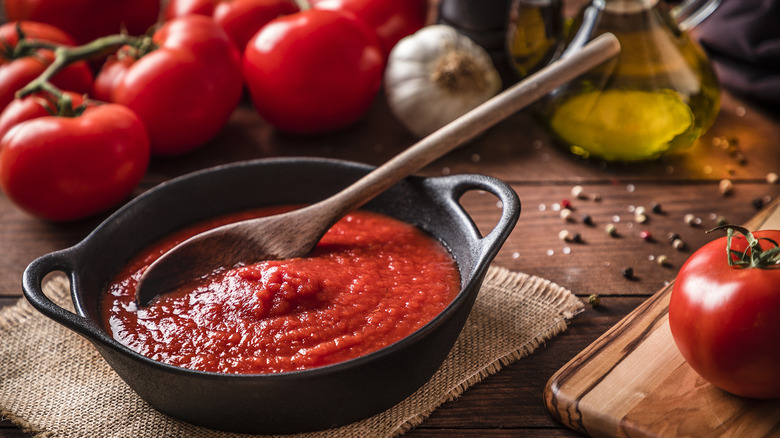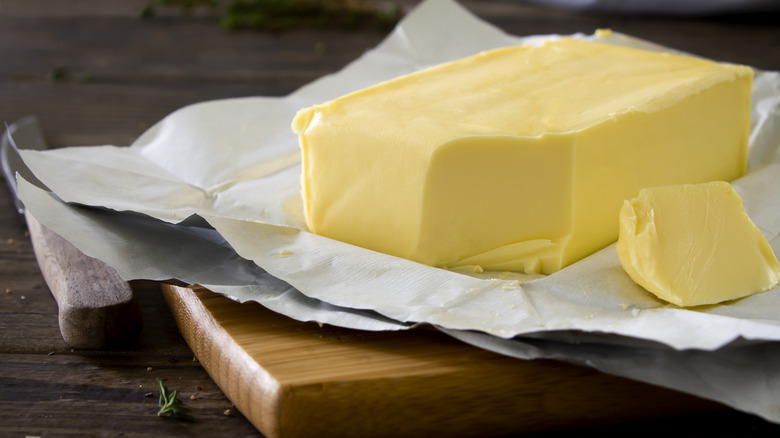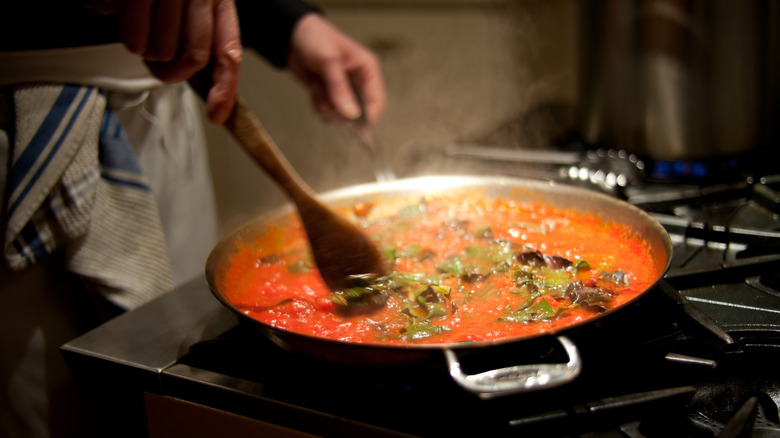The Actual Best Time To Add Butter To Your Pasta Sauce
If you want to make a restaurant-worthy pasta sauce, the secret is butter. Whether you're whipping up a creamy Alfredo or a red tomato gravy, a little bit of the churned dairy product goes a long way toward making your sauce lusciously delectable. But when should you add it? You may be tempted to toss in a few pats as soon as your sauce touches the saucepan. However, doing so would be a faux pas. Instead, if you want a pasta sauce that stands out for all the right reasons (and none of the wrong ones), add your butter at the very end of cooking.
Why is the timing so crucial? Well, butter is an emulsion, a mixture of two things that do not normally mix together — namely, water and oil. If you add your it too soon in the cooking process, then you risk undoing that emulsion, which will break your pan sauce. Part of the butter will cook off due to the high heat of the stove, and only the oily, fatty parts will remain. You can avoid this entire issue by adding it toward the end of cooking. This way, the butter doesn't have time to evaporate from your pan, and you'll have a nice creamy sauce for your guests.
Know when to remove your pan from the heat
Just as you wouldn't want to add butter to your sauce at the beginning, you'll also want to avoid adding it when your pan is piping hot. It would be tragic to ruin everything at the very end, so you should move your pan off the heat and wait a minute for some heat to dissipate. You still want it to be hot enough to melt the butter, though, or it won't incorporate properly. When adding the dairy product to your sauce, stick to teaspoon-sized pats rather than large chunks for more even melting.
Depending on what kind of sauce you're making, you might opt to saute some onions or garlic in butter before adding the rest of the ingredients. If so, you should still add an additional pat or two at the end of the cooking time to further enrich your sauce. If you're uncertain about how much to use, start conservatively and go from there. You can try anywhere from around 2 to 5 tablespoons for every 2 cups of canned tomatoes (the best you can find) initially. If you run out of butter, olive or sesame oil can improve the consistency and flavor of your sauce, but there are rules to consider when selecting a butter substitute. But even if you find yourself with an entire basket of churned Normandy cream, there are other ways timing affects how you should add butter to your pasta sauce.
Use cold butter for your pasta sauces
Okay, you've just melted your butter in the microwave, and you're about to add it to your pasta sauce — stop! While at a glance, it may seem like you can get a jump on the cooking process by melting your butter beforehand, you actually should hold off on doing so. Contrary to conventional wisdom, it's better to add a cold stick of butter to your pasta sauce rather than melted or room-temperature butter.
Using cold butter allows it to mix and emulsify into your pasta sauce at a slower rate. Regardless of whether you're going for a slightly creamy sauce or a really rich sauce, it's important to mix the butter in slowly. Doing so will avoid one of its pitfalls — making things greasy rather than creamy and cohesive. If you try to use melted butter, it will have a harder time combining with the sauce seamlessly in your pan. Instead, you'll likely be left with an unsightly sheen of oil on top of your pasta sauce.
When done right, butter can fortify your pasta sauce and really elevate its flavor — especially if you're using a tomato-based sauce since it balances the sweetness and acidity. Nevertheless, it's all too easy to mess up if you hastily add it at the wrong time. In this case, patience pays off (as does finishing your pasta in the pan).


